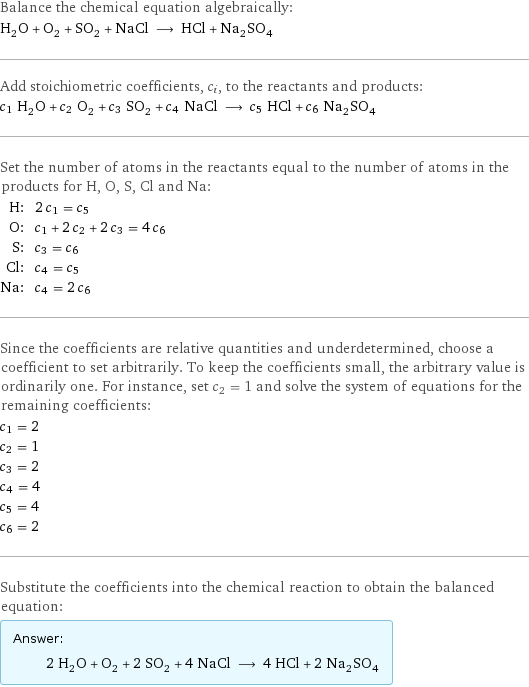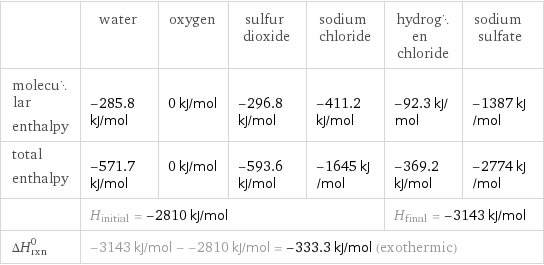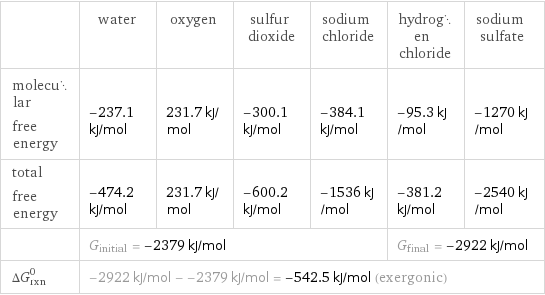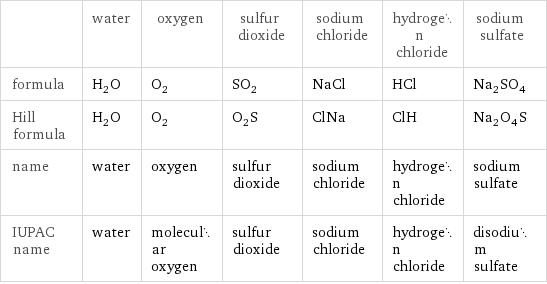Input interpretation

H_2O water + O_2 oxygen + SO_2 sulfur dioxide + NaCl sodium chloride ⟶ HCl hydrogen chloride + Na_2SO_4 sodium sulfate
Balanced equation

Balance the chemical equation algebraically: H_2O + O_2 + SO_2 + NaCl ⟶ HCl + Na_2SO_4 Add stoichiometric coefficients, c_i, to the reactants and products: c_1 H_2O + c_2 O_2 + c_3 SO_2 + c_4 NaCl ⟶ c_5 HCl + c_6 Na_2SO_4 Set the number of atoms in the reactants equal to the number of atoms in the products for H, O, S, Cl and Na: H: | 2 c_1 = c_5 O: | c_1 + 2 c_2 + 2 c_3 = 4 c_6 S: | c_3 = c_6 Cl: | c_4 = c_5 Na: | c_4 = 2 c_6 Since the coefficients are relative quantities and underdetermined, choose a coefficient to set arbitrarily. To keep the coefficients small, the arbitrary value is ordinarily one. For instance, set c_2 = 1 and solve the system of equations for the remaining coefficients: c_1 = 2 c_2 = 1 c_3 = 2 c_4 = 4 c_5 = 4 c_6 = 2 Substitute the coefficients into the chemical reaction to obtain the balanced equation: Answer: | | 2 H_2O + O_2 + 2 SO_2 + 4 NaCl ⟶ 4 HCl + 2 Na_2SO_4
Structures

+ + + ⟶ +
Names

water + oxygen + sulfur dioxide + sodium chloride ⟶ hydrogen chloride + sodium sulfate
Reaction thermodynamics
Enthalpy

| water | oxygen | sulfur dioxide | sodium chloride | hydrogen chloride | sodium sulfate molecular enthalpy | -285.8 kJ/mol | 0 kJ/mol | -296.8 kJ/mol | -411.2 kJ/mol | -92.3 kJ/mol | -1387 kJ/mol total enthalpy | -571.7 kJ/mol | 0 kJ/mol | -593.6 kJ/mol | -1645 kJ/mol | -369.2 kJ/mol | -2774 kJ/mol | H_initial = -2810 kJ/mol | | | | H_final = -3143 kJ/mol | ΔH_rxn^0 | -3143 kJ/mol - -2810 kJ/mol = -333.3 kJ/mol (exothermic) | | | | |
Gibbs free energy

| water | oxygen | sulfur dioxide | sodium chloride | hydrogen chloride | sodium sulfate molecular free energy | -237.1 kJ/mol | 231.7 kJ/mol | -300.1 kJ/mol | -384.1 kJ/mol | -95.3 kJ/mol | -1270 kJ/mol total free energy | -474.2 kJ/mol | 231.7 kJ/mol | -600.2 kJ/mol | -1536 kJ/mol | -381.2 kJ/mol | -2540 kJ/mol | G_initial = -2379 kJ/mol | | | | G_final = -2922 kJ/mol | ΔG_rxn^0 | -2922 kJ/mol - -2379 kJ/mol = -542.5 kJ/mol (exergonic) | | | | |
Equilibrium constant
![Construct the equilibrium constant, K, expression for: H_2O + O_2 + SO_2 + NaCl ⟶ HCl + Na_2SO_4 Plan: • Balance the chemical equation. • Determine the stoichiometric numbers. • Assemble the activity expression for each chemical species. • Use the activity expressions to build the equilibrium constant expression. Write the balanced chemical equation: 2 H_2O + O_2 + 2 SO_2 + 4 NaCl ⟶ 4 HCl + 2 Na_2SO_4 Assign stoichiometric numbers, ν_i, using the stoichiometric coefficients, c_i, from the balanced chemical equation in the following manner: ν_i = -c_i for reactants and ν_i = c_i for products: chemical species | c_i | ν_i H_2O | 2 | -2 O_2 | 1 | -1 SO_2 | 2 | -2 NaCl | 4 | -4 HCl | 4 | 4 Na_2SO_4 | 2 | 2 Assemble the activity expressions accounting for the state of matter and ν_i: chemical species | c_i | ν_i | activity expression H_2O | 2 | -2 | ([H2O])^(-2) O_2 | 1 | -1 | ([O2])^(-1) SO_2 | 2 | -2 | ([SO2])^(-2) NaCl | 4 | -4 | ([NaCl])^(-4) HCl | 4 | 4 | ([HCl])^4 Na_2SO_4 | 2 | 2 | ([Na2SO4])^2 The equilibrium constant symbol in the concentration basis is: K_c Mulitply the activity expressions to arrive at the K_c expression: Answer: | | K_c = ([H2O])^(-2) ([O2])^(-1) ([SO2])^(-2) ([NaCl])^(-4) ([HCl])^4 ([Na2SO4])^2 = (([HCl])^4 ([Na2SO4])^2)/(([H2O])^2 [O2] ([SO2])^2 ([NaCl])^4)](../image_source/993e385c87e6b577ae13154bfdcb1c62.png)
Construct the equilibrium constant, K, expression for: H_2O + O_2 + SO_2 + NaCl ⟶ HCl + Na_2SO_4 Plan: • Balance the chemical equation. • Determine the stoichiometric numbers. • Assemble the activity expression for each chemical species. • Use the activity expressions to build the equilibrium constant expression. Write the balanced chemical equation: 2 H_2O + O_2 + 2 SO_2 + 4 NaCl ⟶ 4 HCl + 2 Na_2SO_4 Assign stoichiometric numbers, ν_i, using the stoichiometric coefficients, c_i, from the balanced chemical equation in the following manner: ν_i = -c_i for reactants and ν_i = c_i for products: chemical species | c_i | ν_i H_2O | 2 | -2 O_2 | 1 | -1 SO_2 | 2 | -2 NaCl | 4 | -4 HCl | 4 | 4 Na_2SO_4 | 2 | 2 Assemble the activity expressions accounting for the state of matter and ν_i: chemical species | c_i | ν_i | activity expression H_2O | 2 | -2 | ([H2O])^(-2) O_2 | 1 | -1 | ([O2])^(-1) SO_2 | 2 | -2 | ([SO2])^(-2) NaCl | 4 | -4 | ([NaCl])^(-4) HCl | 4 | 4 | ([HCl])^4 Na_2SO_4 | 2 | 2 | ([Na2SO4])^2 The equilibrium constant symbol in the concentration basis is: K_c Mulitply the activity expressions to arrive at the K_c expression: Answer: | | K_c = ([H2O])^(-2) ([O2])^(-1) ([SO2])^(-2) ([NaCl])^(-4) ([HCl])^4 ([Na2SO4])^2 = (([HCl])^4 ([Na2SO4])^2)/(([H2O])^2 [O2] ([SO2])^2 ([NaCl])^4)
Rate of reaction
![Construct the rate of reaction expression for: H_2O + O_2 + SO_2 + NaCl ⟶ HCl + Na_2SO_4 Plan: • Balance the chemical equation. • Determine the stoichiometric numbers. • Assemble the rate term for each chemical species. • Write the rate of reaction expression. Write the balanced chemical equation: 2 H_2O + O_2 + 2 SO_2 + 4 NaCl ⟶ 4 HCl + 2 Na_2SO_4 Assign stoichiometric numbers, ν_i, using the stoichiometric coefficients, c_i, from the balanced chemical equation in the following manner: ν_i = -c_i for reactants and ν_i = c_i for products: chemical species | c_i | ν_i H_2O | 2 | -2 O_2 | 1 | -1 SO_2 | 2 | -2 NaCl | 4 | -4 HCl | 4 | 4 Na_2SO_4 | 2 | 2 The rate term for each chemical species, B_i, is 1/ν_i(Δ[B_i])/(Δt) where [B_i] is the amount concentration and t is time: chemical species | c_i | ν_i | rate term H_2O | 2 | -2 | -1/2 (Δ[H2O])/(Δt) O_2 | 1 | -1 | -(Δ[O2])/(Δt) SO_2 | 2 | -2 | -1/2 (Δ[SO2])/(Δt) NaCl | 4 | -4 | -1/4 (Δ[NaCl])/(Δt) HCl | 4 | 4 | 1/4 (Δ[HCl])/(Δt) Na_2SO_4 | 2 | 2 | 1/2 (Δ[Na2SO4])/(Δt) (for infinitesimal rate of change, replace Δ with d) Set the rate terms equal to each other to arrive at the rate expression: Answer: | | rate = -1/2 (Δ[H2O])/(Δt) = -(Δ[O2])/(Δt) = -1/2 (Δ[SO2])/(Δt) = -1/4 (Δ[NaCl])/(Δt) = 1/4 (Δ[HCl])/(Δt) = 1/2 (Δ[Na2SO4])/(Δt) (assuming constant volume and no accumulation of intermediates or side products)](../image_source/e318b84bbf0ca64e1d41f069f9a1b812.png)
Construct the rate of reaction expression for: H_2O + O_2 + SO_2 + NaCl ⟶ HCl + Na_2SO_4 Plan: • Balance the chemical equation. • Determine the stoichiometric numbers. • Assemble the rate term for each chemical species. • Write the rate of reaction expression. Write the balanced chemical equation: 2 H_2O + O_2 + 2 SO_2 + 4 NaCl ⟶ 4 HCl + 2 Na_2SO_4 Assign stoichiometric numbers, ν_i, using the stoichiometric coefficients, c_i, from the balanced chemical equation in the following manner: ν_i = -c_i for reactants and ν_i = c_i for products: chemical species | c_i | ν_i H_2O | 2 | -2 O_2 | 1 | -1 SO_2 | 2 | -2 NaCl | 4 | -4 HCl | 4 | 4 Na_2SO_4 | 2 | 2 The rate term for each chemical species, B_i, is 1/ν_i(Δ[B_i])/(Δt) where [B_i] is the amount concentration and t is time: chemical species | c_i | ν_i | rate term H_2O | 2 | -2 | -1/2 (Δ[H2O])/(Δt) O_2 | 1 | -1 | -(Δ[O2])/(Δt) SO_2 | 2 | -2 | -1/2 (Δ[SO2])/(Δt) NaCl | 4 | -4 | -1/4 (Δ[NaCl])/(Δt) HCl | 4 | 4 | 1/4 (Δ[HCl])/(Δt) Na_2SO_4 | 2 | 2 | 1/2 (Δ[Na2SO4])/(Δt) (for infinitesimal rate of change, replace Δ with d) Set the rate terms equal to each other to arrive at the rate expression: Answer: | | rate = -1/2 (Δ[H2O])/(Δt) = -(Δ[O2])/(Δt) = -1/2 (Δ[SO2])/(Δt) = -1/4 (Δ[NaCl])/(Δt) = 1/4 (Δ[HCl])/(Δt) = 1/2 (Δ[Na2SO4])/(Δt) (assuming constant volume and no accumulation of intermediates or side products)
Chemical names and formulas

| water | oxygen | sulfur dioxide | sodium chloride | hydrogen chloride | sodium sulfate formula | H_2O | O_2 | SO_2 | NaCl | HCl | Na_2SO_4 Hill formula | H_2O | O_2 | O_2S | ClNa | ClH | Na_2O_4S name | water | oxygen | sulfur dioxide | sodium chloride | hydrogen chloride | sodium sulfate IUPAC name | water | molecular oxygen | sulfur dioxide | sodium chloride | hydrogen chloride | disodium sulfate